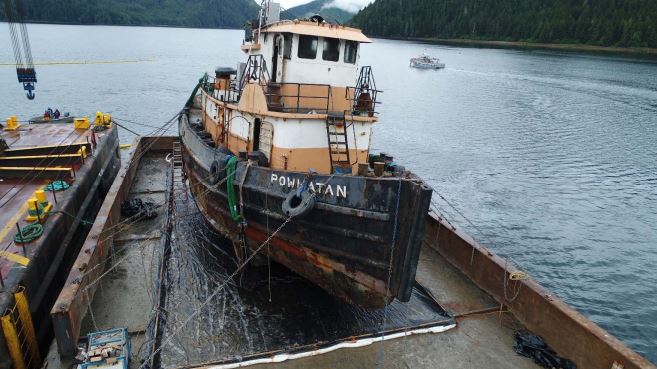
A 2017 tugboat sinking in Sitka has resulted in a settlement of $1.3 million from the National Pollution Funds Center.
The amount of fuel spilled from the sunken tug – while not large – came at a critical time in the life cycle of herring in Sitka Sound.
The tugboat Powhatan sank at its mooring in Starrigavan Bay, just north of Sitka, on April 17, 2017. Sinkings aren’t uncommon in Sitka, and it wasn’t until a few days later that the state Department of Environmental Conservation issued a situation report, and residents learned this was unexpectedly bad: The Powhatan – which we at KCAW were still learning to pronounce – had been dragged by currents into deep water, with over 300 gallons of fuel on board.*
Here’s what Sitkans heard on the news:
2017 KCAW newscast excerpt: “A tugboat with over 300 gallons of oil aboard sank Wednesday night in Sitka. The 81 foot tugboat Powhatan, owned by SamsonTug & Barge, sank at its dock in Starrigavan Bay. The tug then slid under the pier and drifted about 300 yards offshore, where it was located by divers from Hanson Maritime Company.”
The tug’s owner (Samson Tug & Barge), the DEC, the Coast Guard, and SEAPRO – the Southeast Alaska Petroleum Response Organization – all responded, deployed boom, and eventually defueled the Powhatan.
But by then, the damage had been done.
“At that emergent life stage, it does not take very much oil to have an injury to herring,” said Erika Ammann, a biologist with the National Marine Fisheries Service, and one of the co-authors of the “Final Damage Assessment and Restoration Plan for the Tug Powhatan Oil Spill.” In March, the news in Sitka is all about herring and their eggs: The commercial sac roe fishery, the subsistence roe-on-hemlock harvest. In April, after everyone – marine mammal, fish, human, bird – has had their fill of eggs, the herring larvae hatch. That’s right when the Powhatan sank, and that’s why it was so serious, although not nearly as large as a famous blowout in the Gulf of Mexico seven years earlier.
“It wasn’t that the spill was incredibly large,” Ammann said, “It wasn’t a Deepwater Horizon or anything like that. But the just the timing of it, and the location of it, was what really struck us as something that was important for us to pay attention to, and to have some kind of restoration for.”
Using data from herring spawn surveys conducted that spring by the Alaska Department of Fish & Game, along with aerial photographs of the extent of the visible oil sheen, plus research on the susceptibility of herring larvae to diesel fuel, Ammann’s team estimated that 25.4 billion juvenile herring had died in the spill. That kind of precision was possible, Ammann says, because of the Sitka Sound Science Center, which under then-research director Tory O’Connell had joined the effort to learn how badly herring had been affected.
“That’s what we hope to be as a local Science Center, is a responsive, local agency that can respond to need when when it arises,” said Lauren Bell, the current research director at the Sitka Sound Science Center. The Center could play a large role in the restoration plan for the Powhatan spill. After the tug’s owner reached the limits of liability for the accident, the National Marine Fisheries Service applied to the Oil Spill Liability Trust (which is administered by the National Pollution Funds Center), and this past June settled for $1.3 million. The lion’s share of that money will be divided between two projects: for increased shellfish monitoring on Starrigavan Beach by the Sitka Tribe, and for marine debris cleanup on beaches where herring commonly spawn.
The Science Center already has the logistics in place and cleans beaches every year. Bell says removing marine debris is advantageous for herring.
“It’s helping with with returning natural sediment flow in these habitats, and not interfering with the permeability of those sediments,” said Bell. “So my understanding is that if you have marine debris in an environment, that it can… stress the seaweeds and sea grasses that are in the area, and all that abrasion and smothering can be bad news for for herring.”
The downside of the restoration plan is that beach cleanup is temporary. Most of the marine debris in Sitka Sound originates elsewhere, and is an ongoing problem.
Erika Ammann says the restoration plan is not a magic bullet to forever protect herring; rather, it’s short-term – and attainable – by design.
“We aren’t assuming that, ‘Oh, you know, we cleaned this and we can walk away and that it will be restored forever,’” said Ammann. “We have a very limited timeline as far as what we think our restoration benefits will be from a single marine debris cleanup.”
The Powhatan was on the bottom of Starrigavan Bay for almost two months before crews managed to bring it up with an enormous crane in the middle of June, 2017.
2017 KCAW newscast excerpt: “Last week salvage crews raised the Powhatan and placed it aboard a barge for a ride south to a Seattle scrapyard.”
That would be the end of the story, except in Sitka Sound the story never ends. Just last year, during the height of the herring spawn in March, yet another ocean-going tug, the Western Mariner, ran aground in Olga Strait, just a few miles from where the Powhatan went down. Because herring eggs are less vulnerable than larvae, the Western Mariner fuel spill may prove less harmful overall. Erika Ammann says she’s working to find out.
*UPDATE 9-8-23: In public comments following the publication of a draft DARPA (Damage Assessment and Restoration Plan) for the Powhatan spill, Polaris Applied Sciences disputed the estimated size of the Powhatan spill. Simply based on the extent of observable sheen, Polaris calculated that the amount of fuel spilled was closer to 5,000 gallons, rather than 300.






























